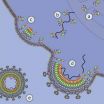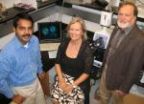(Press-News.org) New insights into the human immunodeficiency virus (HIV) infection process, which leads to acquired immunodeficiency syndrome (AIDS), may now be possible through a research method recently developed in part at the National Institute of Standards and Technology (NIST), where scientists have glimpsed an important protein molecule's behavior with unprecedented clarity.
The HIV protein, known as Gag, plays several critical roles in the assembly of the human immunodeficiency virus in a host cell, but persistent difficulties with imaging Gag in a lab setting have stymied researchers' efforts to study how it functions.
"A better understanding of Gag's behavior might allow researchers to develop antiviral drugs that target the HIV assembly process, which remains unassailed by medical science," says Hirsh Nanda, a postdoctoral researcher at the NIST Center for Neutron Research (NCNR) and a member of the multi-institutional research team. "Our method might reveal how to inhibit new viruses as they grow."
The Gag molecule is a microscopic gymnast. At different stages during HIV assembly, the protein twists itself into several different shapes inside a host cell. One shape, or conformation, helps it to drag a piece of HIV genetic material toward the cell membrane, where the viral particles grow. Gag's opposite end becomes anchored there, stretching the protein into a rod-like conformation that eventually helps form a barrier surrounding the infectious genes in the finished virus. But while scientists have been aware for years that Gag appears to play several roles in HIV assembly, the specifics have remained mysterious.
The research team potentially solved this problem by creating an artificial cell membrane where Gag can show off its gymnastic prowess for the neutron probes at the NCNR. The center includes a variety of instruments specifically designed to observe large organic molecules like proteins.
"We were able to mimic the different stages of the virus's development, and look at what Gag's conformation was at these various stages," Nanda says. "We saw conformations that had never been seen before."
Nanda describes the team's first paper* on the subject as an important first step in describing their observational method, which was a joint effort between NIST, the National Cancer Institute and Carnegie-Mellon University. They plan another paper detailing what the method has revealed about HIV.
"Our efforts have not yet shown us how many steps are involved in Gag's work assembling an HIV particle, but at least we can see what it looks like in each major interaction that likely occurs in the cell during assembly," Nanda says. "It may allow us to characterize them for the first time."
Nanda says that their technique will also allow scientists to examine large classes of membrane proteins, which like Gag are notoriously hard to examine.
INFORMATION:
*H. Nanda, S.A.K. Datta, F. Heinrich, M. Lösche, A. Rein, S. Krueger, J.E. Curtis. Electrostatic interactions and binding orientation of HIV-1 matrix, studied by neutron reflectivity. Biophysical Journal, Vol. 99 (8), Oct. 20, 2010.
New look at multitalented protein sheds light on mysteries of HIV
2010-10-15
ELSE PRESS RELEASES FROM THIS DATE:
New small business law could have big effect on retirement accounts
2010-10-15
CHAMPAIGN, Ill. – A new law aimed at helping stimulate small business job growth through tax deductions could have major consequences for anyone with a retirement savings account at work, a University of Illinois expert on taxation and elder law notes.
Law professor Richard L. Kaplan says an obscure provision in the recently enacted Small Business Jobs Act allows 401(k), 403(b) or 457 account holders to convert their retirement savings into a tax-advantaged Roth-version of the same account.
The good news, according to Kaplan, is that by converting to a Roth variant, ...
This little light of mine: Changing the color of single photons emitted by quantum dots
2010-10-15
Researchers at the National Institute of Standards and Technology (NIST) have demonstrated* for the first time the conversion of near-infrared 1,300 nm wavelength single photons emitted from a true quantum source, a semiconductor quantum dot, to a near-visible wavelength of 710 nm. The ability to change the color of single photons may aid in the development of hybrid quantum systems for applications in quantum communication, computation and metrology.
Two important resources for quantum information processing are the transmission of data encoded in the quantum state of ...
Charcoal biofilter cleans up fertilizer waste gases
2010-10-15
Removing the toxic and odorous emissions of ammonia from the industrial production of fertilizer is a costly and energy-intensive process. Now, researchers in Bangladesh have turned to microbes and inexpensive wood charcoal to create a biofilter that can extract the noxious gas from vented gases and so reduce pollution levels from factories in the developing world.
Writing in the International Journal of Environment and Pollution, Jahir Bin Alam, A. Hasan and A.H. Pathan of the Department of Civil and Environmental Engineering, at Shahjalal University of Science and Technology, ...
Mayo Clinic finds early success with laser that destroys tumors with heat
2010-10-15
JACKSONVILLE, Fla. — Physicians at Mayo Clinic's Florida campus are among the first in the nation to use a technique known as MRI-guided laser ablation to heat up and destroy kidney and liver tumors. So far, five patients have been successfully treated — meaning no visible tumors remained after the procedure.
They join their colleagues at Mayo Clinic's site in Rochester, Minn., who were the first to use laser ablation on patients with recurrent prostate tumors.
Although the treatment techniques are in the development stage, the physicians say the treatment is potentially ...
Perspectives on improving patient care: Genetics, personalized medicine, and behavioral intervention
2010-10-15
Personalized medicine — improving the fit between patient and treatment — has become a major focus of research in fields from cancer treatment to the psychopharmacology of mental disorders. Genetic studies have suggested that an individual's genetic makeup renders him either more or less sensitive to stressful social environments — but can an individual's unique genotype also determine the effectiveness of preventative or therapeutic behavioral interventions?
The current issue of Perspectives on Psychological Science, a journal of the Association for Psychological Science, ...
Study: Waist circumference, not BMI, is best predictor of future cardiovascular risk in children
2010-10-15
Athens, Ga. – A new long-term study published by researchers at the University of Georgia, the Menzies Research Institute in Hobart, Australia and the Murdoch Childrens Research Institute in Melbourne, Australia suggests that waist circumference, rather than the commonly used body mass index measure, is the best clinical measure to predict a child's risk for cardiovascular disease and diabetes later in life.
The researchers, whose results appear in the early online edition of the International Journal of Obesity, found that children with high waist circumference values ...
UT Dallas researcher helps reveal more complete picture of Martian atmosphere
2010-10-15
Instruments designed by a UT Dallas professor to measure atmospheric components on the surface of Mars have uncovered important clues about the planet's atmosphere and climate history.
The findings, published in a recent issue of the journal Science, reveal how carbon dioxide isotopes have reacted to volcanic activity, water and weathering – thus forming a more complete picture of the current Martian atmosphere.
The NASA mission in which this work was accomplished was the Phoenix Lander, an unmanned spacecraft deployed to Mars in 2008.
UT Dallas Physics Professor ...
Anti-vomiting drug could prevent thousands of hospitalizations, save millions of dollars
2010-10-15
CHAPEL HILL – Two years ago, a study by University of North Carolina at Chapel Hill researchers found that an anti-vomiting drug called ondansetron helps reduce vomiting, the need for intravenous fluids and hospital admissions in children with acute gastroenteritis.
Now a new economic analysis led by Canadian researchers, in collaboration with Michael J. Steiner, MD, assistant professor of pediatrics at UNC, concludes that routinely giving ondansetron to children with gastroenteritis-induced vomiting would prevent thousands of hospitalizations and save millions of dollars ...
UCSB scientists discover inner workings of potent cancer drug
2010-10-15
(Santa Barbara, Calif.) –– A potent drug derived from an evergreen tree may soon save the lives of some patients with the deadliest form of breast cancer. According to the National Cancer Institute, breast cancer will claim approximately 40,000 lives in the U.S. this year.
Scientists at UC Santa Barbara, in cooperation with scientists in the pharmaceutical industry, have discovered the mechanism by which this drug kills cancer cells. The team has isolated the drug's action in the test tube as well as in cancer cells.
The results are reported in two studies published ...
Temperature rhythms keep body clocks in sync, UT Southwestern researchers find
2010-10-15
DALLAS – Oct. 14, 2010 – Researchers at UT Southwestern Medical Center have found that fluctuations in internal body temperature regulate the body's circadian rhythm, the 24-hour cycle that controls metabolism, sleep and other bodily functions.
A light-sensitive portion of the brain called the suprachiasmatic nucleus (SCN) remains the body's "master clock" that coordinates the daily cycle, but it does so indirectly, according to a study published by UT Southwestern researchers in the Oct. 15 issue of Science.
The SCN responds to light entering the eye, and so is sensitive ...



